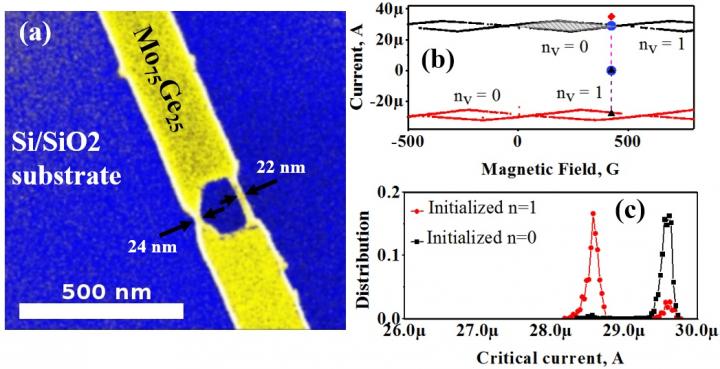Superconducting nanowire memory cell, miniaturized technology

Superconducting nanoscale memory device. The binary information is encoded in the direction of the electrical current in the loop. When the current flows clockwise, this is considered a '0' state of the memory device. When it flows counter clockwise, this is a '1' state of the memory device. Because the electrons are superconducting, the current flows indefinitely in the loops, making the memory nonvolatile. (a) A photograph of the memory device, consisting of a superconducting strip of Mo75Ge25 (yellow) with a pair of superconducting nanowires forming a closed loop (also yellow): The width of the nanowires is 24 nm and 22 nm, as marked. (b) The critical current, i.e., the maximum current which can be injected into the device without destroying superconductivity, is plotted as a function of magnetic field. To set the memory state '0', we apply positive current targeting the shaded diamond. To set the memory to the state '1', a negative current is applied (as the same external magnetic field). To read out the memory state, the current is ramped to a higher value, as shown by the red rhombus, and the current value at which voltage occurs is measured. Such value is the critical current. Its statistical distribution is shown in (c). The measured value of the critical current depends on the pre-set memory value, '0' or '1'. Thus by measuring the critical current we are able to determine the state of the memory cell. Images courtesy of Alexey Bezryadin and Andrew Murphey, University of Illinois at Urbana-Champaign
Researchers at the University of Illinois at Urbana-Champaign have developed a new nanoscale memory cell that holds tremendous promise for successful integration with superconducting processors. The new technology, created by Professor of Physics Alexey Bezryadin and graduate student Andrew Murphy, in collaboration with Dmitri Averin, a professor of theoretical physics at State University of New York at Stony Brook, provides stable memory at a smaller size than other proposed memory devices.
The device comprises two superconducting nanowires, attached to two unevenly spaced electrodes that were “written” using electron-beam lithography. The nanowires and electrodes form an asymmetric, closed superconducting loop, called a nanowire 'SQUID' (superconducting quantum interference device). The direction of current flowing through the loop, either clockwise or counterclockwise, equates to the “0” or “1” of binary code.
The memory state is written by applying an oscillating current of a particular magnitude, at a specific magnetic field. To read the memory state the scientists ramp up the current and detect the current value at which superconductivity gets destroyed. It turns out that such destruction or critical current is different for the two memory states, “0” or “1”.
The scientists tested memory stability, delaying reading of the state, and found no instances of memory loss. The team performed these experiments on two nanowire SQUIDS, made of the superconductor Mo75Ge25, using a method called molecular templating. The results are published in the June 13, 2017 New Journal of Physics (v.19, p.063015).
Bezryadin comments, “This is very exciting. Such superconducting memory cells can be scaled down in size to the range of few tens of nanometers, and are not subject to the same performance issues as other proposed solutions.”
Murphy adds, “Other efforts to create a scaled-down superconducting memory cell weren't able to reach the scale we have. A superconducting memory device needs to be cheaper to manufacture than standard memory now, and it needs to be dense, small, and fast.”
Up to now, the most promising supercomputing memory devices, called 'single-flux quanta' devices, rely on manipulating circuits composed of Josephson junctions and inductive elements. These are in the micrometer range, and miniaturization of these devices is limited by the size of the Josephson junctions and their geometric inductances. Some of these also require ferromagnetic barriers to encode information, where Bezryadin and Murphy's device does not require any ferromagnetic components and eliminates magnetic-field cross-talk.
“Because the kinetic inductance increases with decreasing cross-sectional dimensions of the wire, nanowire SQUID memory elements could be reduced further, into the range of tens of nanometers,” Bezryadin continues.
The researchers argue that this device can operate with a very low dissipation of energy, if the energies of two binary states are equal or near equal. The theoretical model for such operations was developed in collaboration with Averin The switching between the states of equal energy will be achieved either by quantum tunneling or by adiabatic processes composed of multiple jumps between the states.
In future work, Bezryadin plans to address the measurements of the switching time and to study larger arrays of the nanowire squids in functioning as arrays of memory elements. They will also test superconductors with higher critical temperatures, with the goal of a memory circuit that would operate at 4 Kelvin. Rapid operations will be achieved by utilizing microwave pulses.
###
This research is supported by the National Science Foundation, Division of Materials Research.
Media Contact
All latest news from the category: Materials Sciences
Materials management deals with the research, development, manufacturing and processing of raw and industrial materials. Key aspects here are biological and medical issues, which play an increasingly important role in this field.
innovations-report offers in-depth articles related to the development and application of materials and the structure and properties of new materials.
Newest articles

A ‘language’ for ML models to predict nanopore properties
A large number of 2D materials like graphene can have nanopores – small holes formed by missing atoms through which foreign substances can pass. The properties of these nanopores dictate many…

Clinically validated, wearable ultrasound patch
… for continuous blood pressure monitoring. A team of researchers at the University of California San Diego has developed a new and improved wearable ultrasound patch for continuous and noninvasive…

A new puzzle piece for string theory research
Dr. Ksenia Fedosova from the Cluster of Excellence Mathematics Münster, along with an international research team, has proven a conjecture in string theory that physicists had proposed regarding certain equations….



